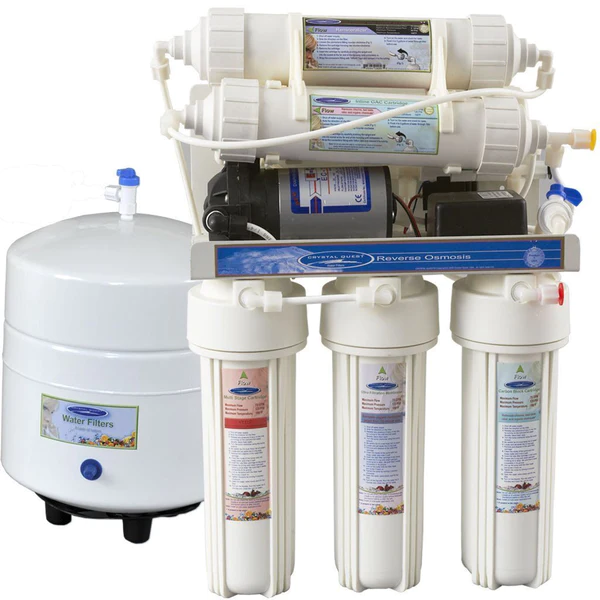Approximately 1 billion pounds of pesticides are used every year across the USA to manage weeds and other pests – According to USGS. Although pesticides are essential to agricultural management, they can contaminate surface and groundwater, which are essential sources of drinking water and should be removed.
Reverse Osmosis systems that have an activated carbon filter can effectively remove certain pesticides from water. Some dissolved pesticides, such as endrin, are removed by the semi-permeable membrane, while other pesticides, as well as their volatile organic compounds, are absorbed by activated carbon filtration media.
This article will explain what pesticides are, how pesticides enter our water supply, the health effects of pesticides, and the efficiency of reverse osmosis systems to remove pesticides. We also include the five effective RO systems for removing pesticides and information on where you can buy a pesticide water testing kit.
Does Reverse Osmosis Remove pesticides from Water?
The Environmental Protection Agency (EPA) asserts that reverse osmosis has been proven to be highly successful in removing certain pesticides; however, detailed data on many pesticides are not yet accessible and more testing is required.
Some pesticides that can be removed by Reverse Osmosis are-
- Endrin
- Heptachlor
- Lindane
- Pentachlorophenol
- Tributyl phosphate
- Flutriafol
- Dicofol
- Irgarol
- Deisopropylatrazine
Household RO systems that use Activated Carbon filters can remove
- 1,2,4-trichlorobenzene,
- 2,4-Dichlorophenoxyacetic acid (2,4-D)
- Atrazine
The RO process is not effective at removing some volatile organic compounds (VOCs)
Drinking Water Treatment: An Overview
Pesticides: What are they?
A pesticide is a chemical used in the environment to kill or control pests. There are a lot of different kinds, with various uses. They are made for spraying on fields so that they can kill weeds and insects.
Farmers use particular pesticides, which contain chemical compounds that prevent diseases and pests on their crops.
- Insecticides are often used to kill insects and keep them from eating crops.
- Herbicides, like Roundup, are used to kill weeds and grasses.
- Fungicides are used to kill fungi and mildew. They also make crops resistant to pests, such as corn, wheat, and soybeans. These chemicals are commonly applied to fields and farmlands.
In addition to being used in agriculture, homes, and places of business, pesticides are also applied to suburban lawns and gardens, as well as along roadways, in recreational areas, on animals kept as pets, and on cattle. According to USGS, in the United States, there are literally hundreds of different kinds of pesticide compounds currently in use.
A pesticide product contains two primary ingredients:
- Active ingredients: A plant regulator, defoliant, desiccant, or nitrogen stabilizer are all examples of “active ingredients,” as are preventing, destroying, repelling, or mitigating the effects of a pest.
- Inert ingredients: According to federal law, all other substances are referred to as “inert ingredients.” They contribute greatly to the performance and functionality of the product.
How Pesticides Enter Our Water Supply
Extracts with groundwater
Soil absorbs pesticides that can percolate down to the groundwater. Pesticides are frequently used in agricultural settings, and it is possible for them to enter the groundwater or surface water systems that provide our drinking water supply.
Approximately half of the country’s population relies on groundwater as their primary source of drinking water. In fact, according to USGS, around 95% of people in agricultural areas, where pesticides are more commonly used, get their drinking water from groundwater.
Evaporated Spray pesticides
The second point on the list gets overlooked but one that can have an outsized impact on the bottom line: the fact that pesticide spray evaporates and can come to the ground as rain.
Pesticides can transport to the atmosphere at the time of application or even after the application in the soil. These evaporated pesticides then fall back to earth and are carried by precipitation and dry deposition to areas where streams and groundwater are.
Pesticides can flow into underground water-bearing aquifers through surface water contamination, accidental spills and breaches, inappropriate disposal, and even through the injection of trash into wells- USGS.
Rainfall and Irrigation
Rainfall can carry pesticides into waterways. This happens when the chemicals in the rainwater are deposited on land and come into contact with the groundwater and surface water. It can also happen if chemicals are simply washed off and fields are flooded.
Irrigation can bring pesticides into streams, rivers, lakes, and other bodies of water. Chemicals can be applied through sprinklers, drip irrigation systems, and other methods. Chemicals can also run off of land where crops are grown.
Health Effects of pesticides
Acute Effects (Immediate effects)
The acute effects, often known as the immediate impacts of pesticides, are those that can cause harm or illness to humans almost immediately after exposure.
According to Californians to Pesticides Reform (CPR), the Acute Effects of pesticides are-
- Nausea
- Stinging eyes
- Rashes
- Blisters
- Blindness
- Dizziness diarrhea
- Vomiting
- Diarrhea
- Death
Chronic Effects (Within weak, months or years)
Chronic effects are the longer-term effects on physical and psychological health that may develop over a lifetime of exposure to pesticides. Research by CPR shows that there are many chronic health conditions that can be linked to pesticide exposure.
- Cancer and other tumors
- Birth Defects
- Reproductive harm
- Immunotoxicity
- Neurological and developmental toxicity
- Disruption of the endocrine system
- Organs damage (Kidney, Lungs, etc.)
What is Reverse Osmosis?
In Reverse Osmosis (RO), pollutants in water are removed by passing through membranes that enable water molecules to flow through, but do not allow the contaminants to pass through. The principle behind RO is osmosis, which dictates that water is forced through a membrane.
Process of Reverse Osmosis
Reverse Osmosis involves applying pressure to the side of the membrane containing the concentrated solution (the contaminated side). This pressure is known as osmotic pressure. This causes the osmotic process to go into reverse, and when sufficient pressure is applied, it causes clean water to go from the side where it is concentrated (which is contaminated) to the side where it is diluted (which is treated).
A storage container collects the treated water after it has been processed. A wastewater filter removes the impurities that cannot pass through the concentrate side of the membrane.
Reverse Osmosis Systems For Pesticide Removal
1. Crystal Quest RO Water Filter – 1000CP

Crystal Quest RO under sink water filter can remove 99.9% herbicides, insecticides, and pesticides.
2. FreshPoint 5-Stage Undercounter RO Filter GRO-575M
The Pentair FreshPoint 5-Stage RO System has a carbon block with two chambers that can remove atrazine, a type of pesticide.
3. APEC Water Systems Ultimate RO
APEC Water Systems Ultimate RO‘s highest grade 5-stage system can remove up to 99% of contaminants including some pesticides.
How to Test for pesticides in Water?
Enzymatic test kits are one of the ways to test pesticides in water. These test kits are often meant to be handheld and portable. Using a cholinesterase enzyme reaction, these tests can determine whether or not chemical agents, organophosphate pesticides, or carbamate pesticides are present in an area.
You can also send samples of your water to a reputable water testing company which can help check the presence of pesticides in the water.

A Specialized Pesticides Water test kit from MyTapScore costs $205.00 and is very good for testing various pesticide pollutants. The test results will include a comprehensive and quantitative analysis of organochlorine pesticides, insecticides, and herbicides according to EPA Method 525.2. (or equivalent).
Upon Ordering:
- They’ll send out the kit and instructions on how to collect the samples.
- You send off the samples (shipping is already paid).
- Samples are tested in their independent and certified laboratory.
- You’ll get the results in about 10 days.
For more information and to order your specialized Pesticides water testing kit click here.
Can you filter out pesticides from well water?
Reverse osmosis (RO) and Granulated Activated Carbon (GAC) filters effectively remove a wide range of pollutants, including certain pesticides from well water. Whenever well water tests positive for pesticides, it’s important to determine which pesticides are present.
Pesticides that can remove by RO and GAC filters are-
- Endrin
- Heptachlor
- Lindane
- Tributyl phosphate
- Flutriafol
- Dicofol
- Irgarol
- Deisopropylatrazine
- Pentachlorophenol
- 1,2,4-trichlorobenzene,
- 2,4-D, Atrazine
So, if your well water tests positive for any of the pesticides listed above, you can eliminate them using RO and GAC filters.
What Happens if I Drink Water with pesticides in it?
Pesticides are poisonous chemicals used to kill insects, weeds, and other unwanted plants. If you drink water with a high amount of pesticides, you can get Acute Health Effects such as chemical burns, nausea, Vomiting, Diarrhea, or convulsions.
However, when pesticides are found in water supplies, they are typically not present in high amounts to induce acute health effects.
Can you boil off pesticides?
Boiling water does not effectively remove pesticides. Some chemical components of pesticides can volatilize (become vapors) and can be inhaled. Other components remain in the water, and if repeatedly boiled can become increasingly concentrated. For these same reasons, distillation is also not an effective means of removing pesticides from water.
Ultimately, you cannot rely on boiling water alone to remove all traces of chemicals from a substance. All pesticides are composed of chemical compounds, and almost without exception, these molecules are notoriously unstable when exposed to high temperatures.



